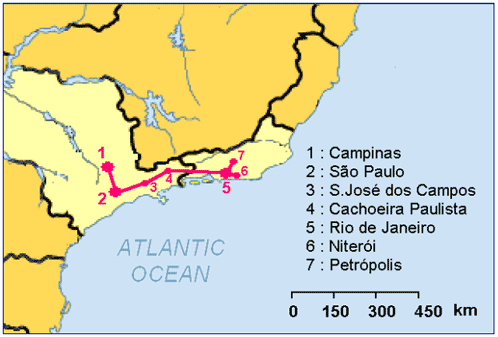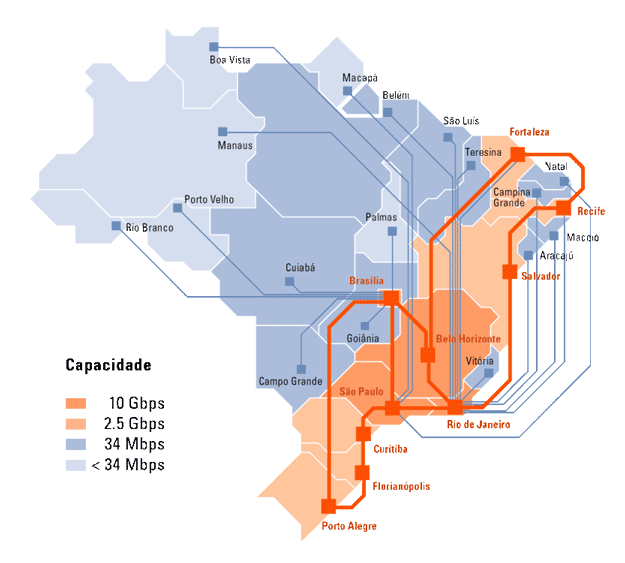With the objective of developing and deploying new optical networking technologies, CPqD 2 and RNP formed a partnership to build an optical testbed network, connecting seven cities in the adjoining states of Rio de Janeiro and São Paulo. This project, named GIGA 3, has been supported financially since December 2002 by the federal government's Fund for the Development of Telecommunications Technology (FUNTTEL) and has resulted in building a 700 km network using dark fiber provided without cost by four telcos and lit up using WDM optical equipment produced by PADTEC, a spin-off of CPqD. This network provides IP service over Gigabit Ethernet to end users in 17 research institutions and four telcos in seven cities (see Figure 1). Most users are R&D groups developing subprojects of Project GIGA, under contract to CPqD or RNP. For RNP, the establishment of this optical networking testbed was the first step in implementing its long-term strategy, known as the National Optical Initiative (ION), which emphasizes the provision of future networking services to end-users through a "facilities-based" infrastructure, such as dark fiber or WDM waves, rather than one based on renting telco-provided services, such as ATM or SDH/Sonet.
The testbed network built by Project GIGA has provided extensive hands-on experience in the design, deployment and operation of both metropolitan and long-distance optical networks, and thus has served as a basis for future development of networks to serve the wider research and higher education community. Within RNP, forward network planning has been heavily influenced by the experience gained in Project GIGA, particularly related to identifying and serving particular user groups, and also as regards the technologies employed. Attention has also been given to new directions in networking adopted in other countries during the last five years, highlighted by such initiatives as National Lambda Rail 4, CAnet4 5 and SURFnet6 6, among others, and widely reviewed in the excellent series of reports produced by the European SERENATE study 7. It was decided that RNP should accompany the global tendency to increase the link capacities of its national network to multiple Gbps. This was in fact undertaken in November, 2005, but was preceded by a migration to SDH/Sonet links starting in 2003, with the abandonment of ATM and Frame Relay (FR) as link technologies. The fact that this first migration could be achieved with an increase in aggregate link bandwidth of around six times (from 350 Mbps in 2003 to over 2 Gbps in 2005) with a 30% reduction in cost is a reflection of a combination of newer technologies and the introduction of competition in the telecommunications marketplace.
In 2005, RNP moved onto the next stage of its ION strategy, replacing the links between the 10 principal cities of its national network by a solution in the form of unprotected, transparent lambdas (waves) of 2.5 and 10 Gbps. The core of what is now known as the IPÊ 8 network (see Figure 2) was commissioned in November. The increase in aggregate link bandwidth for this IPÊ network core is from around 1.6 Gbps (SDH) to 60 Gbps (waves), or almost 40 times, at only three times the cost! In fact, the overall cost of the whole national network is now just 30% more than in 2003, for an increase in aggregate bandwidth of almost 180 times. As an essential complement to the deployment of the IPÊ network, RNP is also engaged in a nationwide project, known as Community Networks for Education and Research (Redecomep), to deploy optical metropolitan area networks in all 27 capital cities by December 2006. These networks are designed to provide gigabit access to the RNP point of presence (PoP), as well as interconnecting all the campi of RNP clients in these metro areas 1. International connectivity for RNP's IPÊ network is based on links to commodity networks and also research and education connections (RE) directly connecting to other RE networks (REN), such as CLARA (the regional Latin American REN), Abilene (US NREN), CalREN (California REN), Géant (European REN), among others. A summary of these is shown in Table 3.
 Figure 1. Location of the Project GIGA testbed network (2004)
|
 Figure 2. IPË network in 4Q2005
|
| Type | Comment |
|---|---|
| Commodity | 310 Mbps from Rio de Janeiro and 45 Mbps from S. Paulo via Global Crossing |
| RE | 155 Mbps (with possible temporary extensions to up to 622 Mbps) from São Paulo via CLARA network, which connects to most other national RENs in Latin America at up to 155 Mbps, to Géant at 622 Mbps through a São Paulo-Madrid link, and to CalREN at 1 Gbps through a Tijuana (México)-San Diego link. The CLARA network was built through the European Union's ALICE project 9. |
| RE | To the USA through a S. Paulo-Miami link with 1.2 Gbps bandwidth, shared with the São Paulo state network (ANSP), as from January 2006 (This link, like the Tijuana-San Diego link, are provided through the WHREN/LILA project 10 of NSF's International Research Networks Connections (IRNC) program). |






